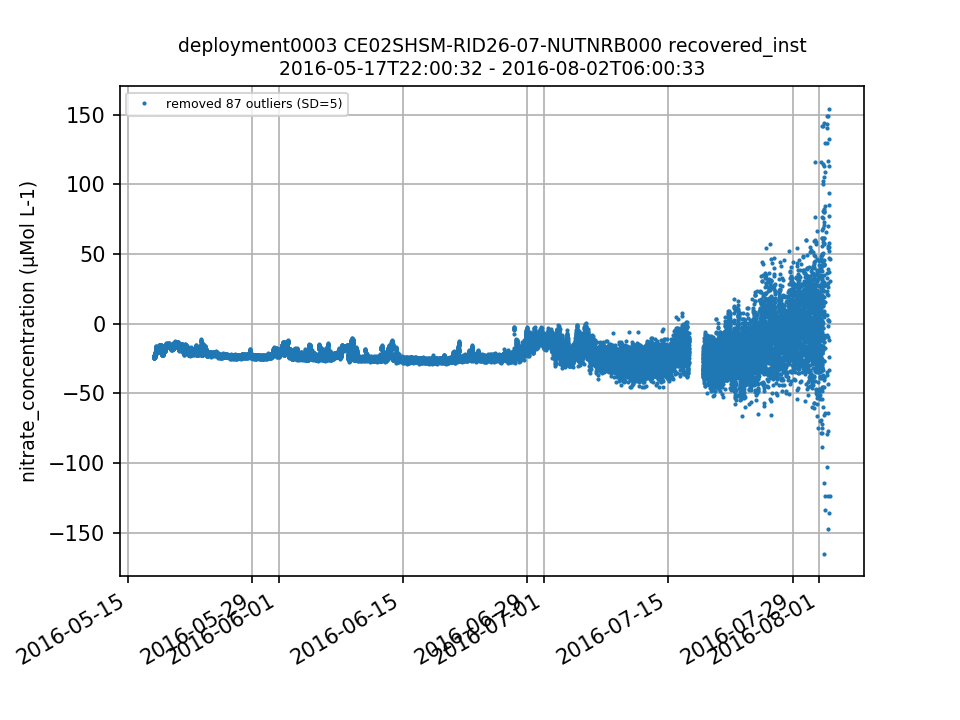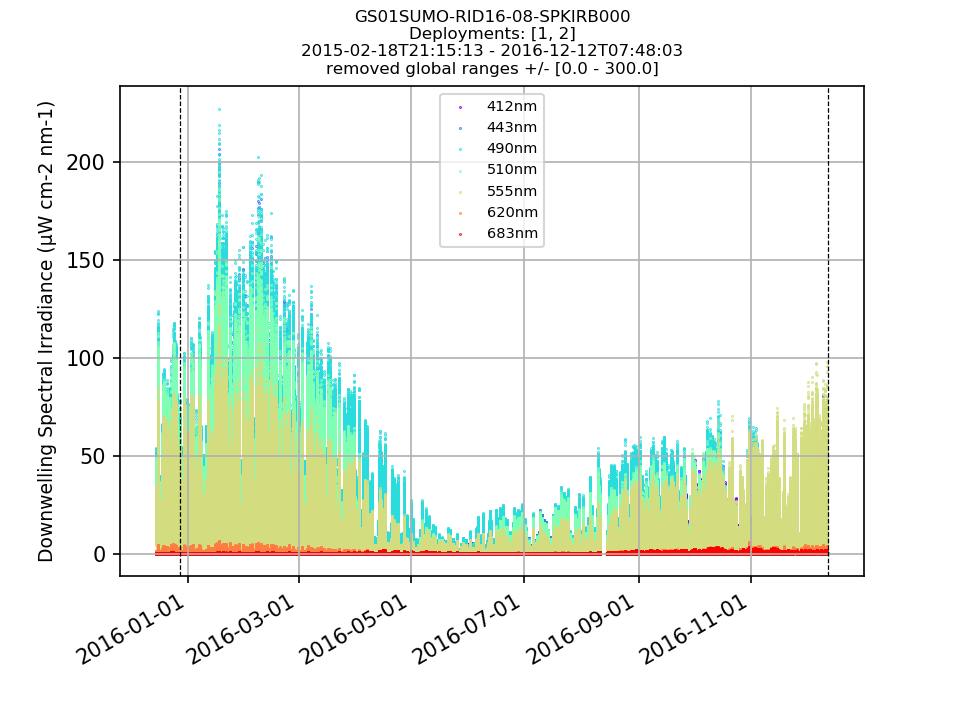Notes
Sort by:| Metadata | Start Date | End Date | Comment |
|---|---|---|---|
|
CE02SHSM-RID26-07-NUTNRB000 Deployment: 3 |
5/17/16, 9:23 PM | 9/28/16, 3:52 PM | |
|
CE02SHSM-RID26-07-NUTNRB000 Deployment: 2 |
10/7/15, 9:10 PM | 5/16/16, 9:09 PM | |
|
CE02SHSM-RID26-07-NUTNRB000 Deployment: 1 |
4/2/15, 8:15 PM | 9/22/15, 7:48 AM | |
|
CE02SHSM-RID26-07-NUTNRB000 |
Annotation ID 1409 should be updated when the parser is complete and the data from the new instruments is ingested. By Lori Garzio, on 7/23/19 |
||
|
CE02SHSM-RID26-07-NUTNRB000 |
Missing data for deployments 1-5 should be annotated. By Lori Garzio, on 7/23/19 |
||
|
CE02SHSM-RID26-07-NUTNRB000 |
There is no pressure variable in the .nc files. This should be a coordinate. By Lori Garzio, on 7/23/19 |
||
|
GS01SUMO-RID16-08-SPKIRB000 Deployment: 2 |
9/1/16, 12:00 AM | 12/12/16, 7:58 AM |
Downwelling spectral irradiance should start increasing again in Sept (after the austral winter). This increase is observed to a certain extent in the data from this instrument at the end of 2016 for some wavelengths (555, 620nm), but not in the data from other wavelengths. This could indicate possible biofouling. Data are suspect - this should be investigated and annotated. By Lori Garzio, on 7/12/19 |
|
GS01SUMO-RID16-08-SPKIRB000 Deployment: 2 |
35% of data are outside of global ranges for this deployment. Zooming in on the x-axis in the plots shows that all of the values that are outside of global ranges are negative. By Lori Garzio, on 7/12/19 |
||
|
GS01SUMO-SBD11-05-SPKIRB000 |
Missing data should be annotated (e.g. the majority of deployment 1 isn't available). By Lori Garzio, on 7/12/19 |
||
|
GS01SUMO-SBD11-05-SPKIRB000 |
A substantial percentage (between 11-29%) of data are outside of global ranges for both deployments. Zooming in on the x-axis in the plots shows that all of the values that are outside of global ranges are negative. By Lori Garzio, on 7/12/19 |
||
|
GI01SUMO-RID16-08-SPKIRB000 |
A substantial percentage (between 9-40%) of data are outside of global ranges for every deployment. Zooming in on the x-axis in the plots shows that all of the values that are outside of global ranges are negative. By Lori Garzio, on 7/12/19 |
||
|
GI01SUMO-SBD11-05-SPKIRB000 |
A substantial percentage (between 22-50%) of data are outside of global ranges for every deployment. Zooming in on the x-axis in the plots shows that all of the values that are outside of global ranges are negative. By Lori Garzio, on 7/12/19 |
||
|
GA01SUMO-RID16-08-SPKIRB000 Deployment: 3 |
9/1/17, 12:00 AM | 1/14/18, 10:24 AM |
Downwelling spectral irradiance should start increasing again in Sept (after the austral winter). This increase is seen in the data from the SPKIR on the surface buoy, and is observed to a certain extent in the data from this instrument at the end of 2017 for wavelength=555nm, but not in the data from other wavelengths. This could indicate possible biofouling. Data are suspect - this should be investigated and annotated. By Lori Garzio, on 7/12/19 |
|
GA01SUMO-SBD11-05-SPKIRB000 |
A substantial percentage (between 10-29%) of data are outside of global ranges for every deployment. Some of the values that are outside of global ranges are negative, and some of the values outside of global ranges are on the high end. (global ranges = 0-300) By Lori Garzio, on 7/12/19 |
||
|
GA01SUMO-SBD11-05-SPKIRB000 |
Missing data, particularly for deployment 1, should be annotated. By Lori Garzio, on 7/12/19 |
||
|
GA01SUMO-RID16-08-SPKIRB000 Deployment: 2 |
5/1/16, 12:00 AM | 11/8/16, 10:10 AM | |
|
GA01SUMO-RID16-08-SPKIRB000 |
A substantial percentage (between 25-33%) of data are outside of global ranges for every deployment. Zooming in on the x-axis in the plots shows that all of the values that are outside of global ranges are negative. By Lori Garzio, on 7/12/19 |
||
|
CP04OSSM-RID26-08-SPKIRB000 Deployment: 6 |
Missing data for this deployment should be annotated. By Lori Garzio, on 7/12/19 |
||
|
CP04OSSM-RID26-08-SPKIRB000 |
A substantial percentage (between 19-38%) of data are outside of global ranges for every deployment. Zooming in on the x-axis in the plots shows that all of the values that are outside of global ranges are negative. By Lori Garzio, on 7/12/19 |
||
|
GS01SUMO-RID16-08-SPKIRB000 Deployment: 1 |
All values for spkir_abj_cspp_downwelling_vector for this deployment are fill values. By Lori Garzio, on 7/12/19 |




